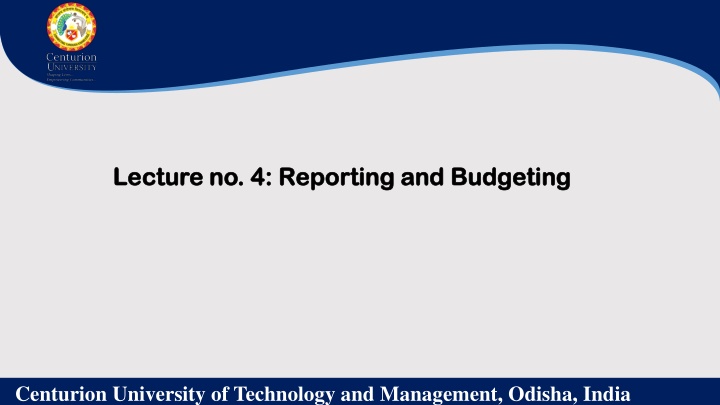
Reporting, Budgeting, and Stakeholder Engagement in Financial Management
Learn about the importance and key aspects of reporting, budgeting, and stakeholder engagement in financial management. Reporting involves financial statements, KPIs, and management reports, while budgeting includes revenue forecasting and budget development. Stakeholder reporting ensures transparency and accountability to external parties.
Download Presentation

Please find below an Image/Link to download the presentation.
The content on the website is provided AS IS for your information and personal use only. It may not be sold, licensed, or shared on other websites without obtaining consent from the author. If you encounter any issues during the download, it is possible that the publisher has removed the file from their server.
You are allowed to download the files provided on this website for personal or commercial use, subject to the condition that they are used lawfully. All files are the property of their respective owners.
The content on the website is provided AS IS for your information and personal use only. It may not be sold, licensed, or shared on other websites without obtaining consent from the author.
E N D
Presentation Transcript
Lecture Lecture no no. . 4 4: : Reporting Reporting and and Budgeting Budgeting Centurion University of Technology and Management, Odisha, India
Reporting:Reporting involves the collection, analysis, and presentation of financial and non-financial information to stakeholders within and outside the organization. It provides a snapshot of the organization's performance, financial health, and progress towards its goals. Here are key aspects of reporting: 1.Financial Statements: Financial statements, including the income statement, balance sheet, and cash flow statement, provide a summary of the organization's financial performance, assets, liabilities, and cash flows. These statements are typically prepared in accordance with accounting standards and provide a comprehensive view of the organization's financial position. Centurion University of Technology and Management, Odisha, India
2. Key Performance Indicators (KPIs): KPIs are quantitative or qualitative metrics that help assess the organization's performance against its objectives. They can include financial metrics (e.g., revenue growth, profit margin) and non-financial metrics (e.g., customer satisfaction, employee productivity). Reporting KPIs allows management to track progress and make informed decisions. 3. Management Reports: Management reports provide detailed information on specific areas of the organization's operations, such as sales, marketing, or production. These reports help managers monitor performance, identify trends, and make data-driven decisions. They can include budget variance analysis, sales reports, operational efficiency reports, and more. Centurion University of Technology and Management, Odisha, India
Stakeholder Reporting: Organizations may also prepare reports for external stakeholders, such as investors, lenders, and regulators. These reports provide transparency and accountability to external parties and often follow specific reporting guidelines or regulations. Budgeting: Budgeting is the process of planning and allocating financial resources to achieve organizational goals. It involves estimating income, projecting expenses, and setting financial targets. Here are key aspects of budgeting: Centurion University of Technology and Management, Odisha, India
1. Revenue and Expense Forecasting: Budgeting starts with forecasting expected revenues and estimating expenses for a given period, typically for a fiscal year. Revenue forecasts can be based on historical data, market trends, and sales projections. Expense estimates cover various categories, such as salaries, supplies, marketing, and overhead costs. 2. Budget Development: Once revenue and expense projections are determined, the budget is developed by allocating resources to different departments, projects, or cost centers. This involves setting financial targets, determining spending limits, and aligning budget allocations with strategic priorities. Centurion University of Technology and Management, Odisha, India
3. Budget Monitoring and Control:Throughout the budget period, actual performance is tracked against the budgeted targets. This involves monitoring expenses, revenue generation, and other financial metrics. Budget variances are analyzed to identify deviations from the plan, and corrective actions may be taken if necessary. 4. Rolling Forecasts and Adjustments: Budgets are not set in stone and can be adjusted based on changing circumstances or new information. Some organizations adopt rolling forecasts, where budgets are updated periodically to reflect the latest assumptions and market conditions. This allows for flexibility and adaptation to dynamic business environments. 5. Cost Management: Budgeting also involves managing costs effectively. This includes evaluating cost-saving opportunities, analyzing cost structures, and optimizing resource allocation to maximize efficiency and profitability. Centurion University of Technology and Management, Odisha, India
6. Budget Communication: Clear communication of the budget and its components is crucial. Managers and employees should understand the budgetary goals, their roles in achieving them, and any constraints or expectations related to financial resources. Reporting and budgeting are closely linked processes. Reports provide insights into the organization's financial performance, which can inform future budgeting decisions. Budgets, on the other hand, set financial targets and provide a framework for tracking and controlling expenses. Together, these processes help organizations manage their financial resources, make informed decisions, and achieve their strategic objectives. Centurion University of Technology and Management, Odisha, India
Budget A budget is an organisational plan in financial terms. The financial document is used to estimate future income and expenses. A budget can also serve as a plan for action for achieving quantified objectives, standard for measuring performance and a device for coping with foreseeable adverse situations. A balance which is entered in a general ledger at the start of a year (1 January) and represents the net balance of income less expenditure for a fund, at the end of the preceding year (31 December). Brought forward balances Forecast Is a projection about the year-end position, based on a number of factors including the use of historical data and current information and knowledge. It is developed in conjunction with the financial planning and budget team and budget managers during the year. Management Reporting Management reporting is a detailed report of the actual year to date position and a full year forecast. It includes a Profit and Loss statement, cash flow balances and a Balance Sheet. Centurion University of Technology and Management, Odisha, India
